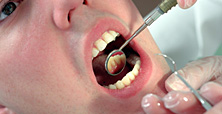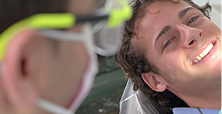Public

Temporomandibular Disorder (TMD)
Overview:
After many years, temporomandibular disorder (TMD) still remains a contentious subject matter in present dentistry. To this day, dentists and physicians still really don't understand its cause, prevention, and treatment. Even though there is much uncertainty about TMD, it seems to be a rather widespread disorder. Millions of individuals have had TMD at various times in their lives, with women aged 20-40 years being the majority.
Usually, TMD does not lead to more severe, long-standing difficulties. It has been shown that people with TMD will in due course improve whether or not they have treatment. However, some of these TMD sufferers will have severe discomfort or strong pain lasting several years.
Temporomandibular Joint (TMJ) and Temporomandibular Disorder
TMD does not represent a single problem, but a group of problems involving the jaw joint, i.e., temporomandibular joint (TMJ), along with its associated muscles that control the movement of the jaw, biting and chewing. The TMJ is similar to a ball and socket joint. Upon opening your mouth, the ball (i.e., condyle) moves forward out of the joint (i.e., glenoid fossa). Upon closing, it slides back smoothly into the joint socket. What makes this joint special, it that there is a disk that is soft and acts like a cushion between the condyle and glenoid fossa. This disk moves with the jaw, absorbs forces, and keeps the two bones of the joint from rubbing against each other. This joint is encapsulated by muscles that stretch from the mandible to the top of the skull.
The TMJ permits your mouth to open, close, shift from side-to-side, and forward and backward. This permits you to talk, yawn, bite, chew and swallow. These joint can be felt by putting your finger on both sides of your face immediately in front of your ears, and opening and closing your mouth This way, you can feel your condyles moving in and out the glenoid fossa.
TMD can be classified three ways: Difficulties affecting the neck and jaw muscles; difficulties affecting the cartilage and bones inside the joint; and difficulties that involve both of these classifications. Some individuals have TMD difficulties that can involve more than one classification.
Symptoms:
There are many diverse symptoms of TMD, and some of these can be similar to other disease states. So, many physicians have difficulty making a diagnosis of TMD. TMD is most commonly associated with discomfort or pain in the muscles used for chewing or the joint of the jaw. Additional symptoms include:
- Cracking, snapping or rasping sounds with jaw movements;
- Not being able to open your mouth fully;
- Neck, face, and shoulder pains;
- Facial muscles being tired;
- Sudden and uncomfortable biting (i.e., feeling like your upper and lower teeth don't bite together properly;
- Facial swelling;
- Toothaches, headaches, earaches, ringing in the ears, and hearing problems; and,
- Dizziness
Causes:
Many experts are uncertain about TMD causes, and feel that the symptoms may result from:
- Some type of damage involving the chin, jaw, or TMJ, possibly resulting from a fall, fight, or automobile accident. Opening the mouth too wide can also cause TMJ difficulties;
- Prolonged or habitual clenching or grinding of the teeth, can also place much pressure on the TMJ;
- Disk dislocation;
- Arthritis, for example rheumatoid arthritis or osteoarthritis; and,
- Stress, causing people to clench their teeth and tighten their jaw and facial muscles. There are cases where dentists haven't been able to detect what causes an individual's TMD.
Diagnosis:
Sometimes, TMD symptoms are very similar to other medical problems, thus making it difficult for a dentist or physician to diagnose. There are no recognized procedures to follow to diagnose TMD, and no tests that will give the dentist a definite diagnosis of TMD. If TMD is suspected by your dentist, your medical history will be reviewed, including: 1) All of your symptoms; 2) when they began; 3) If they are intermittent or constant; 4) whether and how your life is affected by them; 5) if you have other disorders, such as arthritis; 6) whether you are taking any medications; and 7) if there were any stress causing changes in your life now or recently. The dentist will also perform a physical examination which entails: 1) feeling you jaw joints and muscles of the face; 2) listening for clicking, crackling or popping noises were you are opening and closing your mouth; and 3) examining the teeth for unusual wear patterns, grinding, clenching, or interferences while moving your lower jaw sideways and forward. Your dentist may also take X-rays of your jaw, or a panoramic X-ray, so make sure that your TMJ looks normal. This type or oral and facial examination can help your dentist diagnosis your TMJ problems. Other testing may also be required, such as an MRI or other special tests.
- 6-month-smiles
- Abscess Management
- Anti Snoring
- Apicectomy
- Avulsions
- Braces
- Brushing
- Cannine palate
- Cavities
- Child Need Fluoride
- Compact Tuft
- Cosmetic Dentistry
- Crown Lengthening
- Crowns
- Crowns new
- Dental Bonding
- Dental Bridges
- Dental Implants
- Dental Insurance
- Dental Sedation
- Dental Veneers
- Denture Adhesives
- Denture Fixative
- Dentures Wearing
- Dentures
- Fever Blisters
- Fissure Sealants
- Flossing
- Fluoride Supplements
- Fluoride
- Fluorosis
- Fractured and Broken Teeth
- Gingival Flap
- Gingivoplasty
- Halitosis
- Home Teeth
- Impacted-tooth
- Inman-aligner
- Interdental Brushing
- Invisalign
- Jaw
- Loose or Broken wires Brackets
- Lost Filling
- Lumineers
- Mini Flosser
- Nitrous oxide
- Oral Tissue Injuries
- Partially Extruded
- Pericoronitis
- Periodontal Disease
- Proximal Brush
- Pulpotomies
- Rapid Maxillary Expander
- Root Canal Retreatment
- Root Canal
- Root Resorption
- Sensitive Teeth
- Soft Tissue
- Sports Safety
- Stomatitis
- Teeth Scaling
- Teeth Sealants
- Teeth Whitening
- Temporomandibular Disorder
- Tongue Cleaning
- Tooth Discolouration
- Tooth Jewellery
- Treatment Temporomandibular
- Twin Blocks
- Water Fluoridation
- Xerostomia (Dry Mouth)
Dentists
-

Dental Implants
A dental implant is a small man-made titanium fixture that serves as the replacement for the root portion of a missing natural tooth in your mouth. The implant is placed in the bone of your upper or lower jaw into a precisely drilled hole.
Read more... -

6 month smiles
6 Month Braces is a revolutionary orthodontic service for adults who have, until now, felt like they would need to wait 2 years with fixed braces. Until now, if you had crooked teeth, there was a choice between Porcelain Veneers and traditional long-term braces (orthodontics).
Read more... -

Inman Aligner
The Inman Aligner looks like a cross between a removable brace and a sports mouthguard, but is thin and transparent, which means it is virtually invisible, although not as "invisible" as Invisalign™.In addition all movements are achieved with a single aligner
Read more...